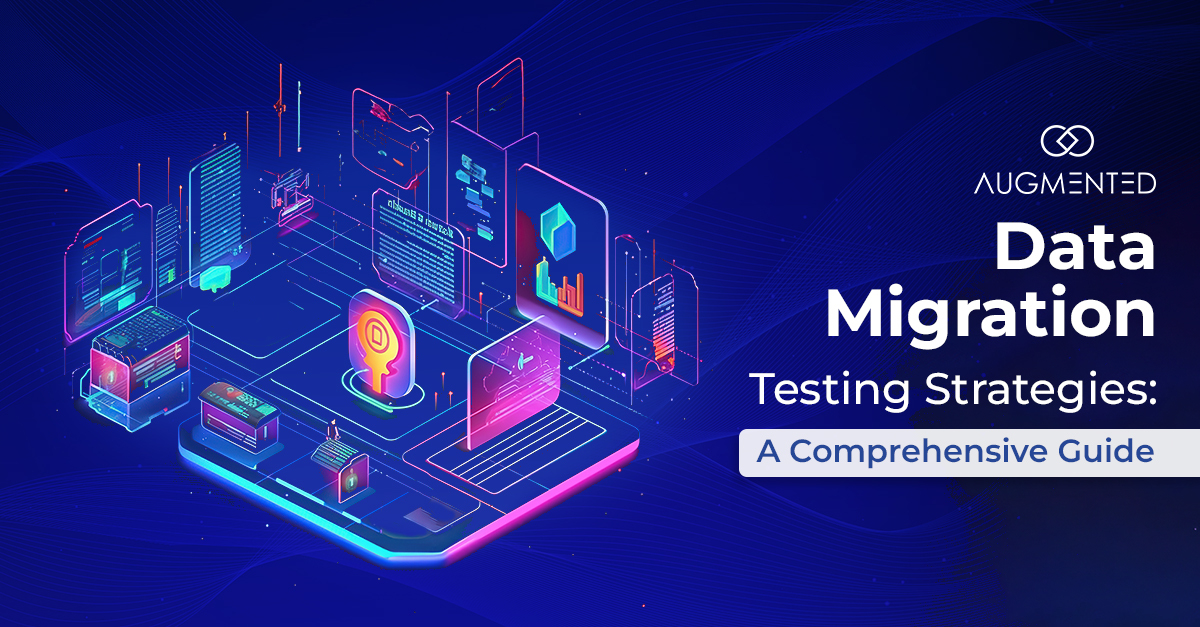Worried that data migration can mess up your data in the new system?
Missing data, wrong details, lost information or poor-quality data are headaches for many. A failed data migration project can jeopardize any business.
So, to implement a successful data migration, prioritize data migration testing. Testing will make your migration smooth without compromising its integrity.
So, to help you ensure a smooth data migration, here is a complete guide on data migration testing strategy. Dig in to not put your data at risk.
The What, Why and When of Data Migration Testing
Data migration from a legacy system to a new system is usually considered a simple job—moving data from place A to place B. But, in reality, it is a much more complex task.
From the initial planning to the final execution, data migration encompasses various steps before, during, and after the migration process. Among these, data migration testing emerges as a pivotal and urgent one, demanding immediate attention.
So, learn about data migration testing, why it’s important, and when to perform it, keep reading.
What is Data Migration Testing?
Data migration testing is a process of assessing data before it is transferred from one source to another during data migration. The testing ensures data accuracy, completeness and consistency.
It involves three main stages:
- Inspection Before Moving: Examine the data before migrating to find what needs to be moved and what needs to stay.
- Monitoring the Data: To quickly fix any problems or hindrances and closely monitor the data.
- Post-move Inspection: Check again to ensure that everything in the new system matches the legacy system.
Why is Data Migration Testing Important?
83% of data migration projects fail or beat their deadlines and budgets. This alone is enough to take data migration testing seriously.
However, that’s not all. Data migration is essential since it ensures:
- Data integrity
- Data loss prevention
- Identification of bottlenecks, issues and breaches
- Customer demands and satisfaction
- System integrity
So, data migration testing is essential to stay compliant with the legal requirements pre- and post-migration.
When is Data Migration Testing Required?
Data migration testing is mandatory for many reasons. Let’s see how.
- Upgrading to a New System: When moving data from one system to another.
- At Each Stage of Migration: Testing is necessary at all stages of migration.
- Migrating to Cloud: When you are transferring your data from on-premise to a cloud platform.
- Merging Systems: When combining or merging data from multiple systems into a single system.
- Database Conversion: When converting data from one format to another.
Before initiating the data migration testing, it is crucial to thoroughly create a data migration test plan. You can also use data migration testing tools for a seamless data migration. Moreover, depending on your needs, you can choose different testing types.
What are the Types of Data Migration Testing?
The dataset and data needs of every business are unique. Different data sizes and data complexity require different tools and testing methods.
Here are four key data migration testing techniques that can help your business achieve optimal results.
1. Functionality Testing
Functional testing is the process of assessing whether the migrated data functions or operates as it did before migration.
Functionality Testing is vital to guarantee that the migrated data retains its intended function. Even if the data appears to transfer, it may not be usable due to underlying issues in its structure.
It focuses on various things including:
- Data Integrity and Quality: Is the data correct and complete?
- Data Relationship: Is the data working together and connecting as expected?
- Data Comparison: Is the new system performing the same as the legacy system?
- Real-use Scenarios: Can the new system handle real-world situations?
- Checking Adherence: Is the data or new system following the business rules and regulations?
Functionality testing helps Q/A engineers ensure that the information or data performs as planned after the move. In other words, it helps them know if it aligns with the migration process's desired outcomes.
2. Performance Testing
Data migration performance testing confirms that the new system improves performance while maintaining overall stability. To measure this improvement correctly, you need to capture performance requirements and benchmark values before migration.
Performance testing focuses on assessing the efficiency of the data migration process in technical terms. Simply, it checks how fast and smooth the data moves to your new system.
It helps assess factors, including:
- It measures the data transfer speed and response time
- Helps catch error occurrences and troubleshoot them.
- It helps identify the amount of strain migration puts on the systems.
Businesses and organizations can identify and fix any bottlenecks by conducting performance testing. They can also use this information to optimize data transfer efficiency and ensure that it doesn't affect the overall system.
3. Security Testing
Security testing is performed to ensure that the data migration process is free of security issues.
Data migration security testing is crucial for safeguarding the migrated data against potential breaches and hindrances. The test helps you keep your data safe during the move.
Security testing, as the word suggests, focuses on:
- Providing user permissions and protection.
- Security testing provides encryption measures.
- It also evaluates the data transmission methods and environments.
- Data masking methods.
Leveraging the security test, you can find any weaknesses or loopholes during the process. This minimizes the risk of unauthorized access or security breaches.
4. Compliance Testing
Compliance testing is done to verify that the migrated data and the entire process adhere to specific rules and regulations during data migration.
Data migration compliance testing helps prioritize protection regulations and industry standards. This ensures that the migrated data follows compliance requirements as it moves from one system to another.
Compliance testing can help you:
- Protect the integrity and privacy of your migrated data.
- Reduce the risk of potential legal and regulatory issues.
- Avoid foreseen monetary implications.
Data migration compliance testing can help you maintain trust and business reputation during migration. It complies with data privacy regulations and security policies.
What are the Phases of Data Migration Testing?
Whatever your business size, migrating critical information and crucial data should not be based on gut feeling. Every phase of data migration testing is crucial.
So, learn how to plan your move and test your process at every phase.
1. Pre-Migration Testing
Pre-migration testing is a set of testing activities performed before migrating the data from an on-premise system to a new system.
Perform the pre-migration test before starting your data migration process. It focuses on setting the stage for a smooth migration.
Steps Involved:
- Plan: Develop a comprehensive data migration plan when planning for a pre-migration test.
- Cleanse: Find and bifurcate the data that you want to migrate and the one you want to leave.
- Prepare: Clearly define the data scope. Identify data sources and set up the environment for migration. Check if the source is compatible with your requirements.
- Perform: Do data mapping at various levels during the migration between legacy and new systems.
- Study: Identify potential risks and ensure data backup. Study the data flow and verify the data after migration.
During this phase, you can start with a small transfer to check that everything works in your favor. A trial run can help you identify potential risks or hindrances. Moreover, it will help you define the potential downtime required for the process.
2. Migration Testing
Phase two of testing is migration testing. It is a set of testing activities that is performed as soon as the data migration process starts. Ideally it starts by backing up the data of the legacy system.
It involves a data migration test plan that helps monitor the migration process in real-time. During an actual migration, this testing phase ensures that your data stream flows continuously and arrives as it is.
Steps Involved:
- Quality Checks: Migrating testing will rigorously assess the quality of the migrated data for accuracy and completeness. You can use specialized tools to check the data quality.
- Integration Testing: This process ensures that the target system interacts smoothly with the legacy system.
- Data Mapping Testing: It verifies that the data mapping is correctly defined between the source and target system.
- Process Testing: These tests ensure that the entire data migration process is completed in a controlled environment. All the end-to-end systems are connected correctly and the new system works as expected.
Once the data arrives in the right place, user testing can be implemented. It will measure whether you or your team can use the new system.
3. Post-Migration Testing
Post-migration testing is a series of follow-up tests done once the migration is complete.
These tests help determine if the migration process was correctly executed. After the data migration process is complete; you can perform post-migration testing to ensure that the data migrated to your new system is not damaged.
Imagine moving to a new home and making sure that everything works as expected. Post-migration testing serves a similar function.
Steps Involved:
- Verify: Be sure that everything works properly.
- Validate: To perform data reconciliation so that the data in the new system is the same as the legacy system.
- Enable: To ensure that users can access all their data
- Performance: To see how well the system handles data volumes and usage speed.
Accurate documentation is essential, detailing every step of the data migration testing strategy.
What are the Data Migration Testing Challenges?
Data migration may present many data migration testing challenges. Navigating these hurdles requires careful planning and a well-researched approach that provides strategic solutions.
Here are some challenges that may hinder your migration process.
- Data Loss: Losing critical data, such as customer information. To prevent loss of data you can perform a back-up before migration.
- Downtime: Data migration testing can extend the period of downtime leading to an overall loss for your business. You can plan to migrate your data during off-peak hours.
- Data Governance: Without proper governance, the data may be mishandled. This may lead to unauthorized access, loss, or corruption. You can implement policies and protocols for your migration process.
- Data Quality: The quality of your data is a major issue during data migration testing. Duplicates and outdated information can easily make the migration process complicated. Rigorously clean your data and validate your data before migrating.
- Data Inconsistency: It is possible that your data in the new system does not match with your data in the legacy system. Therefore take the required steps, such as data mapping, to translate correct data in the target system.
- Data Volume: Data migration testing can become a sheer challenge with the size of your data. It can be time-consuming to test large datasets. So, strategize your testing methods or use automation.
By overcoming these challenges, you can ensure a seamless and stress-free data migration testing process.
Checklist for Data Migration Testing
Data migration testing is not a cakewalk. It needs proper planning and execution. Here is a data migration testing checklist that can make your testing a little easier.
1. Migrate in Stages
Split the entire testing process into smaller and manageable batches. Testing smaller datasets will give you more control and visibility of your data. You can pinpoint and identify issues easily, minimizing the impact on the existing system.
2. Double-check Your Migration Tools
Verify that your migration tools are accurately migrating data from your on-premise system to the new system. You can be extra cautious by having an experienced programmer review the tests. They can help you catch code errors, data mapping issues or identify data loss.
3. Establish User Roles
Secure your new system by setting up user roles and permissions for the new system. Define the access levels for each user within your organization. This could include adding or removing user privileges and implementing secure authentication methods.
4. Data Migration Test Plan
Implement a well-organized test plan for an effective data migration test. Strategically organize and orchestrate your team for successful testing. Provide them with the right data set and environment to run the tests.
Careful planning can ensure that the tests align with the complete migration goal and provide you with the expected results.
5. Reporting the Test Results
Systematic test execution and reporting are crucial elements of data migration testing. Your testing plan will guide you and help you report any issues found in the migrated data.
Keep track of your progress and create a comprehensive report summarizing the test results. Make informed decisions by identifying problems beforehand.
Data migration testing validates the integrity and accuracy of your migrated data. Proper testing can help you identify data discrepancies and take corrective measures.
Tips to Make Your Data Migration Testing Easy
Here are a few tips to reduce the risks associated with data migration testing and make the process easier.
1. Plan
You should have a clear plan for your data before you start the testing phase. Planning the entire process will create a roadmap for a smooth data migration.
- Start by Meticulously Crafting Your Goals. The goals may cover objectives, timelines, resources and potential challenges.
- Also, create a comprehensive data migration test plan to transfer your data accurately and with minimal errors.
- Create consistent formats and structures to simply migrate and minimize errors.
- Focus on the quality of your data. Make your data clutter-free. Eliminate duplicate data for reliable results. Moreover, clean unnecessary, outdated and consistent data or information.
2. Right Approach and Tools
Having the right approach and utilizing the right tools are fundamental for any data migration process.
- Migrate in smaller sets. This will minimize disruptions and downtime and help troubleshoot issues quickly.
- Select tools or software designed especially for your needs. This will aid in automating tasks, reduce errors and boost efficiency.
3. Monitor, Optimize and Document
For real-time feedback, efficient executive of your data transfer, monitor and optimize your data. Moreover, document it throughout for future reference.
- Monitor your migration process closely. Address issues to optimize and ensure a smooth migration process.
- Maintain and document all the plans, procedures, and processes. Transparent documentation will help maintain accountability and knowledge sharing.
Moreover, you can seek help from experienced partners to leverage their expertise and resources. Working with experts will help improve migration success and reduce risks.
Conclusion
A small miss in data migration testing can be risky for overall data migration. It is difficult and prone to mistakes.
Given the complexity and susceptibility to errors, developing a robust data migration testing strategy is essential before starting the testing.
We at Augmented help you plan and design an effective data migration testing strategy. Feel free to contact Augmented Systems our team of experienced testers and robust tools to make your testing feel like a breeze.





